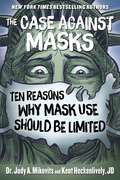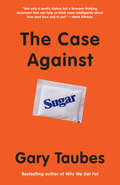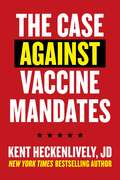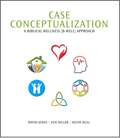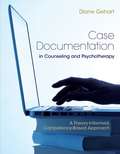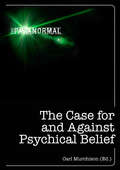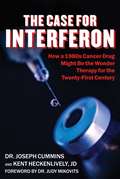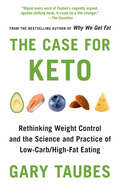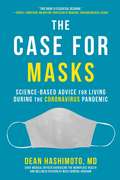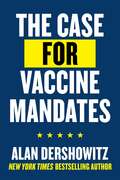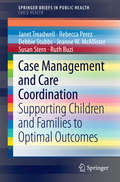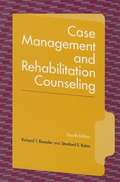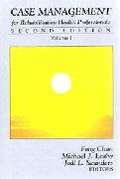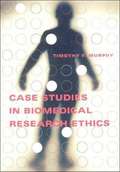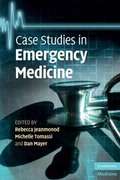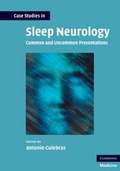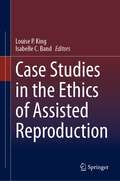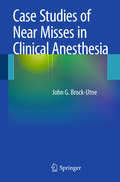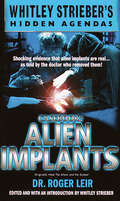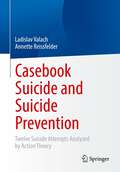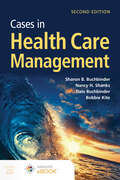- Table View
- List View
The Case Against Masks: Ten Reasons Why Mask Use Should be Limited
by Judy Mikovits Kent HeckenlivelyDo we really need to wear masks? From the New York Times Bestselling authors of Plague of Corruption comes the must-read guide on masks and re-opening following the COVID-19 pandemic. THE CASE AGAINST MASKS is the book all America needs to be reading as we emerge from the COVID-19 pandemic. Written by New York Times bestselling authors Dr. Judy Mikovits and Kent Heckenlively, this book reviews the evidence for and against widespread public masking as provided by the Centers for Disease Control and the Mayo Clinic, as well as top scientific publications such as the New England Journal of Medicine and The Lancet. This debate needs to take place without fear and paranoia. Important questions raised in this book are the affect of masks on oxygen and carbon dioxide levels, how SARS-CoV-2 spreads, the effectiveness of various types of masks, those who are most vulnerable to COVID-19, and whether our children should go back to school in the fall, and if so, what measures they should take.The authors' previous book, PLAGUE OF CORRUPTION, was the runaway science bestseller of 2020, and the authors bring that same passion and attention to detail to the mask question. As politicians and bureaucrats of all stripes are weighing in on this question, with some placing their cities and states under mandatory masking provisions, we need to understand the science behind their decisions. Are such measures a reasonable response to current circumstances, or is it a dramatic overreach, which in many cases might make the situation even worse? America desperately needs this public conversation to take place with the best science we have available. As Americans have always done during difficult times, we must summon the courage to have these challenging conversations.
The Case Against Sugar
by Gary TaubesFrom the best-selling author of Why We Get Fat, a groundbreaking, eye-opening exposé that makes the convincing case that sugar is the tobacco of the new millennium: backed by powerful lobbies, entrenched in our lives, and making us very sick. Among Americans, diabetes is more prevalent today than ever; obesity is at epidemic proportions; nearly 10% of children are thought to have nonalcoholic fatty liver disease. And sugar is at the root of these, and other, critical society-wide, health-related problems. With his signature command of both science and straight talk, Gary Taubes delves into Americans' history with sugar: its uses as a preservative, as an additive in cigarettes, the contemporary overuse of high-fructose corn syrup. He explains what research has shown about our addiction to sweets. He clarifies the arguments against sugar, corrects misconceptions about the relationship between sugar and weight loss; and provides the perspective necessary to make informed decisions about sugar as individuals and as a society.
Case Against Vaccine Mandates
by Kent HeckenlivelyKent Heckenlively, New York Times bestselling author of Plague of Corruption, calls upon both common sense and legal precedence to fight against vaccine mandates around the country. "My body, my choice!" used to be the rallying cry of the left in the abortion fight. But now this same principle of bodily autonomy is the central argument of conservatives, such as that of Florida Governor Ron DeSantis in fierce opposition to so-called "vaccine passports," which would limit whether an individual could attend movies or other public events, work, or even go to school, if they chose to decline a COVID-19 vaccine. While cities like New York close their doors to unvaccinated people, the fight against vaccine mandates is cobbling together an unexpected alliance across the political spectrum, such as the Black mayor of Boston, Kim Janey, who recently claimed, "there's a long history" in this country of people "needing to show their papers" and declaring any such passport as akin to slavery. The starting point agreed upon by all parties as to whether the government can bring such pressure to bear upon individuals is the 1905 US Supreme Court of Jacobson v. Massachusetts. In that case, a Lutheran pastor declined a smallpox vaccination and was fined $5, the equivalent of a little more than $150 in today's currency, or less than many traffic tickets. The Jacobson case sparked a shameful legacy in American jurisprudence, being used as the sole reasoning by the US Supreme Court to allow the forced sterilization of a female psychiatric patient in 1927. This ruling paved the way for the involuntary sterilization of more than sixty thousand mental patients and gave legal justification to the eugenics movement, one of the darkest chapters in American medicine. In The Case Against Vaccine Mandates, New York Times bestselling author Kent Heckenlively, whose books have courageously taken on Big Pharma, Google, and Facebook, now points his razor sharp legal and literary skills against vaccine passports and mandates, which he believes to be the defining issue as to whether we continue to exist as a free and independent people.
Case Conceptualization: Biblical Wellness (B-Well) Approach
by David Jones Ken Miller Kevin HullCase Conceptualization: A Biblical Wellness (B-Well) Approach is developed in a stepwise progression for students and counseling practitioners. The book begins by establishing a clear understanding of wellness and then provides an overview of biblical worldview essentials. After offering these two foundations―wellness and biblical perspective―an integrated biblical wellness model is delivered, the Biblical Wellness (B-Well) model. Next, case conceptualization (CC) is addressed. It is here that you will gain an understanding of the CC process and how to use the B-Well model in that process. Finally, the last chapters deliver an application of the B-Well model by specific theory by counseling discipline―school counseling, clinical mental health counseling, addiction counseling, pastoral counseling, marriage and family counseling, and special populations―using theories such as solution-focused, cognitive behavioral, acceptance and commitment therapy, Adlerian, psychodynamic, family systems, play therapy, and others. <p><p> Case Conceptualization: A Biblical Wellness (B-Well) Approach is intended for students, counselors, counselor educators, and other helping professionals who desire to operate from wellness and a Christian worldview when conducting a clinical case conceptualization. This book seeks to offer the student, practitioner, and educator a coherent case conceptualization process by bridging the gap between wellness and a Christian worldview.
Case Documentation in Counseling and Psychotherapy: A Theory-Informed, Competency-Based Approach
by Diane R. GehartCase Documentation in Counseling and Psychotherapy teaches counselors and psychotherapists how to apply counseling theories in real-world settings. The book provides a comprehensive introduction to case documentation using four commonly used clinical forms: case conceptualization, clinical assessment, treatment plan, and progress note. These documents are uniquely designed to incorporate counseling theory and help new practitioners understand how to use theory in everyday practice. Case studies illustrate how to complete documentation using each of seven counseling models: psychodynamic, Adlerian, humanistic, cognitive-behavioral, family systemic, solution-focused, and postmodern/feminist. <p><p> Readers also learn about the evidence base for each theory as well as applications for specific diverse populations. Outcome-based pedagogy engages readers in an active learning process. The book's case documentation assignments-created using national standards for counseling, family therapy, psychology, and social work-empower readers to apply theoretical concepts and develop professional skills early in their training. With its practical overviews of theories, conceptualization, treatment planning, and documentation, this is a book that future mental health professionals will want to keep and use as a clinical reference manual for years to come.
The Case for and Against Psychical Belief
by Carl MurchisonFourteen Essays On Psychical Phenomena And Mediumship By Fourteen Authors Including Sir Oliver Lodge, Houdini, Mary Austin And Sir Arthur Conan Doyle.
Case for Interferon: How a 1980s Cancer Drug Might Be the Wonder Therapy for the Twenty-First Century
by Kent Heckenlively Dr. Joseph CumminsTouted as a potential breakthrough cancer therapy in the 1980s by the scientific community and publications such as TIME and Newsweek magazine, the reputation of interferon has not lived up to its early promise. Interferons are small proteins with anti-viral and anti-cancer effects, which have the power to modulate the functioning of the immune system. But Dr. Joseph Cummins, an early interferon pioneer, holder of sixteen US medical patents, author of more than sixty scientific publications, as well as having taught veterinary medicine at the University of Missouri, University of Illinois, and Texas A & M University, argues that the current thinking on interferon is fundamentally flawed. Interferon is created in small quantities in the body in response to infection, and seems to work best at these low dosages. However, the public health cowboys, working under the assumption that anything good in tiny amounts must be better in massive amounts, pursued exactly the wrong strategy. High-dose interferon does not work in the body and may even cause problems. The first remarkable results for interferon and the flu were reported by the Soviets in the 1970s, but Western medicine discounted these findings because they believed the dosages were so low they couldn&’t possibly be effective. In the 1980s, when interferon was expensive to produce and only small quantities could be manufactured, the results were remarkable. Dr. Cummins was an early pioneer of low-dose interferon, and his remarkable findings among animals led to collaborations with medical doctors for human trials, even going so far as Africa at the height of the HIV-AIDS epidemic. Cummins reviews the evidence for this inexpensive, safe treatment and makes an eloquent argument for medical science to take another look at interferon to tackle today&’s most challenging health conditions, including COVID-19.
The Case for Keto: Rethinking Weight Control and the Science and Practice of Low-Carb/High-Fat Eating
by Gary TaubesAfter a century of misunderstanding the differences between diet, weight control, and health, The Case for Keto revolutionizes how we think about healthy eating--from the best-selling author of Why We Get Fat and The Case Against Sugar.Based on twenty years of investigative reporting and interviews with 100 practicing physicians who embrace the keto lifestyle as the best prescription for their patients' health, Gary Taubes gives us a manifesto for the twenty-first-century fight against obesity and diabetes.For years, health organizations have preached the same rules for losing weight: restrict your calories, eat less, exercise more. So why doesn't it work for everyone? Taubes, whose seminal book Good Calories, Bad Calories and cover stories for The New York Times Magazine changed the way we look at nutrition and health, sets the record straight.The Case for Keto puts the ketogenic diet movement in the necessary historical and scientific perspective. It makes clear the vital misconceptions in how we've come to think about obesity and diet (no, people do not become fat simply because they eat too much; hormones play the critical role) and uses the collected clinical experience of the medical community to provide essential practical advice. Taubes reveals why the established rules about eating healthy might be the wrong approach to weight loss for millions of people, and how low-carbohydrate, high-fat/ketogenic diets can help so many of us achieve and maintain a healthy weight for life.
The Case for Masks: Science-Based Advice for Living During the Coronavirus Pandemic
by Dean HashimotoThe science behind wearing a mask to stop the spread of Coronavirus, from a top expert in the field. In America, the debate over whether or not masks should be worn to prevent the spread of COVID-19 has become enmeshed with political affiliation, views on religious and personal freedoms, and conflicting media reports on the benefits and dangers of facial coverings. But now, several months into this pandemic, what does science say? What have we learned from international case studies? Dr. Hashimoto, the chief medical officer who oversees the Workplace Health and Wellness division at Mass General Brigham, a Harvard Medical School affiliated healthcare system, presents the current research, making the case that wearing masks in public is a key part of saving lives and bringing this pandemic to a halt. Citing specific examples of situations where infected individuals wore masks versus ones who didn't and how that changed the outcome, as well as population-based studies in individual states and by country, and the undeniable effect that universal masking had on Mass Brigham Hospital's staff of 75,000, Dr. Hashimoto offers a clear and compelling argument for the benefits of masking. In addition, he explains the complementary roles of social distancing, washing hands, coronavirus testing, and face shields, and a thorough exploration of what kinds of masks are most effective at stopping the spread of viruses and how they should be fitted and worn. He addresses safety concerns and medical misconceptions about mask wearing, why the CDC didn't recommend universal mask wearing at the beginning of the pandemic, and how employers can promote mask wearing in their workplaces. Don't wear a mask just because someone told you to. Find out the real reasons for masking and understand the science for yourself.
The Case for Vaccine Mandates
by Alan DershowitzIn The Case for Vaccine Mandates, Alan Dershowitz—New York Times bestselling author and one of America&’s most respected legal scholars—makes an argument, against the backdrop of ideologically driven and politicized objections, for mandating (with medical exceptions) vaccinations as a last resort, if proved necessary to prevent the spread of COVID. Alan Dershowitz has been called &“one of the most prominent and consistent defenders of civil liberties in America&” by Politico and &“the nation&’s most peripatetic civil liberties lawyer and one of its most distinguished defenders of individual rights&” by Newsweek. He is also a fair-minded and even-handed expert on civil liberties and constitutional rights, and in this book offers his knowledge and insight to help readers understand how mandated vaccination and compulsion to wearing masks should and would be upheld in the courts. The Case for Vaccine Mandates offers a straightforward analytical perspective: If a vaccine significantly reduces the threat of spreading a serious and potentially deadly disease without significant risks to those taking the vaccine, the case for governmental compulsion grows stronger. If a vaccine only reduces the risk and seriousness of COVID to the vaccinated person but does little to prevent the spread or seriousness to others, the case is weaker. Dershowitz addresses these and the issue of masking through a libertarian approach derived from John Stuart Mill, the English philosopher and political economist whose doctrine he summarizes as, &“your right to swing your fist ends at the tip of my nose.&” Dershowitz further explores the subject of mandates by looking to what he describes as the only Supreme Court decision that is directly on point to this issue; decided in 1905, Jacobson v. Massachusetts involved a Cambridge ordinance mandating vaccination against smallpox and a fine for anyone who refused. In the end, The Case for Vaccine Mandates represents an icon in American law and due process reckoning with what unfortunately has become a reflection of our dangerously divisive age, where even a pandemic and the responses to it, divide us along partisan and ideological lines. It is essential reading for anyone interested in a non-partisan, civil liberties, and constitutional analysis.
Case Management and Care Coordination: Supporting Children and Families to Optimal Outcomes (SpringerBriefs in Public Health #0)
by Janet Treadwell Rebecca Perez Debbie Stubbs Jeanne W. Mcallister Susan Stern Ruth BuziNew collaborative models of health care service delivery are contributing to quality and cost improvements, especially in treating children and families. At the same time, deficits in communication between systems sharing patients can not only lead to confusion and waste, but also to increased risk of harm. Case Management and Care Coordination offers an evidence-based framework, best practices, and clinical common sense to meet this ongoing challenge. Focusing on families of children with chronic health issues, it outlines the processes of case management and care coordination, clarifies the roles and responsibilities of team members, and models streamlined, patient-centered service delivery. This analysis cuts through much of the complexity of case management while emphasizing collaboration, flexibility, and advocacy in pursuing best outcomes for patients. And as an extra dimension of usefulness, the book is accessible to lay readers, empowering families to make informed decisions and have a more active role in their own care. Included in the coverage: Essential skills for integrated case management. Children and youth with special health care needs. Transitional care and case management settings for children and families. Case management and home visitation programs. Managed care and care coordination. Technology and care coordination. Effectively illustrating the possibilities and potential of health care reform, Case Management and Care Coordination is an essential resource for pediatricians and health care professionals, as well as for families of children with special health care needs.
Case Management and Rehabilitation Counseling: Procedures and Techniques (4th edition)
by Richard Roessler Stanford E. RubinThis book reviews the finer points relating to diagnosing, arranging services, monitoring program outcomes, arranging for placement, planning for accommodations, ethical decision making, dealing with multicultural issues, and managing caseloads.
Case Management for Rehabilitation Health Professionals, Volume 1 (2nd edition)
by Jodi L. Saunders Michael J. Leahy Fong ChanThis two-volume text was written to respond to the pre-service and continuing education needs of rehabilitation counselors and case managers who practice in today's health care and rehabilitation service delivery systems. It is intended to serve as a textbook for students in pre-service training programs and a collateral reading resource for those who wish to gain a deeper knowledge about case management for professional development purposes.
Case Studies in Abnormal Behavior
by Frank SchmallegerTopics discussed: anxiety disorders, sleep disorders, sexual disorders, delusional disorders, depression, substance abuse, violence, eating disorders, among others.
Case Studies in Biomedical Research Ethics
by Timothy F. MurphyThis textbook for instruction in biomedical research ethics can also serve as a valuable reference for professionals in the field of bioethics. The 149 cases included in the book are grouped in nine chapters, each of which covers a key area of debate in the field. Some of the case studies are classics, including the famous cases of the Tuskegee Syphilis Study (in which subjects with syphilis were not given treatment) and the Willowbrook hepatitis studies (in which institutionalized subjects were intentionally exposed to hepatitis). Others focus on such current issues as human embryonic stem cell research, cloning by somatic nuclear transfer, and the design and function of institutional review boards. Each chapter begins with a brief introduction that places the issues raised in context; this is followed by a number of cases (each of which is no more than a few pages). Study questions meant to encourage further discussion follow each case. After an introductory discussion of the history and tenets of ethics in medical research, the book's chapters cover the topics of oversight and study design; informed consent; the selection of subjects; conflicts of interest; the social effects of research; embryos, fetuses, and children; genetic research; the use of animals; and authorship and publication. Following these chapters are appendixes with the texts of the Nuremburg Code and the World Declaration of Geneva, two key documents in the establishment of bioethical standards for research. Also included are a glossary, a table of cases by general category, and an alphabetical listing of cases.
Case Studies in Canadian Health Policy and Management, Second Edition
by Raisa Deber Catherine L. MahCovering a wide range of issues, the 22 cases included in Case Studies in Canadian Health Policy and Management constitute an exceptional resource for bringing real-life policy questions into the classroom. Based on actual events, the cases have been developed with input from mid-career professionals with strong field experience and extensively tested in Raisa B. Deber's graduate case study seminar at the University of Toronto. Each case features both a substantive health policy issue and a selection of key concepts and methods appropriate to examining public policy, public health, and health care management issues.In each case, the authors provide a summary of the case and the related policy issues, a description of events, suggested questions for discussion, supporting information, and both works cited and further reading. Suitable for graduate and undergraduate classrooms in programs in a variety of fields, Case Studies in Canadian Health Policy and Management is an exceptional educational resource.This second edition features all new cases, as well as adding an introductory chapter that provides a framework and tools for health policy analysis in Canada.
Case Studies in Emergency Medicine
by Rebecca Jeanmonod Michelle Tomassi Dan MayerA case-based book organized by the top 10 common complaints of patients presenting to emergency departments. This approach allows the reader to learn the pathophysiology of the major diseases, and analyze each case in a way that more closely approximates the clinical practice of medicine; not knowing which organ system is damaged or compromised before examining the patient. The cases are based on real patients and the diseases are either common in emergency practice, or are dangerous diagnoses not to be missed. The case descriptions include questions regarding the patient's presentation and basic information about the disease, illustrating key elements from the history, physical, and when necessary ancillary studies that help lead to a diagnosis. Each chapter ends with a flow diagram showing how diseases of different organ systems can present with similar initial complaints. This book is an ideal resource for medical students, residents and trainees in emergency medicine.
Case Studies in Polysomnography Interpretation
by Robert C. BasnerThe polysomnogram is a formidable sleep medicine tool, typically incorporating multiple channels of physiologic data including EEG, ECG, EMG, respiratory flow and effort, ventilation via CO2 monitoring, oxygen saturation via pulse oximetry and ventilatory treatment modalities. Aspiring experts must constantly ask themselves questions regarding PSG interpretation such as: Am I confident in using all of these modalities? Can I accurately and consistently distinguish a seizure from a movement disorder; a servo ventilator signal from an auto-titrating continuous positive airway pressure signal; an episode of Cheyne–Stokes breathing from an episode of obstructive sleep apnea? The authors take you into their own sleep laboratories and deliver real-life cases for you to interpret with them. Such expertise is vitally useful for house staff and fellows learning sleep medicine, those seeking Board certification, technologists who score PSGs and seasoned sleep clinicians managing patients with sleep-related health disorders. Every image features on the accompanying CD-ROM.
Case Studies in Sleep Neurology: Common and Uncommon Presentations
by Antonio CulebrasSleep disorders are increasingly recognized as a major clinical problem, with significant morbidity and considerable economic importance. This compendium of case studies presents a diverse range of situations which challenge the problem-solving abilities of all those interested in sleep disorders, covering both common and unusual cases. Each case begins with a clinical history, followed by examination findings and special investigations and culminating in diagnosis, treatment and management, with discussion of differential diagnosis where appropriate. Focusing attention on the major categories of sleep medicine, including insomnia, hypersomnias, sleep-breathing disorders, parasomnias, movement disorders, circadian dysrhythmias and the neurology of sleep, this clinical guide promotes integrative thinking and diagnostic skill. Historical and review citations, illustrations and concise real-life stories stimulate memory and facilitate learning. Written and edited by an international cadre of sleep professionals, this book will inform and challenge established specialists and provide a stimulating teaching tool for those in training.
Case Studies in the Ethics of Assisted Reproduction
by Louise P. King Isabelle C. BandThis book evaluates some of the most common ethical issues confronted by reproductive endocrinologists, embryologists, and their teams. The authors apply core ethical principles and approaches to problem solving to each of the cases raised. This work is a guide for both those on the front lines of patient care as well as for students in the field, whatever their background. By outlining sample cases, the book is an instigator for ethical discussions among ethicists, medical practitioners and students.
Case Studies of Near Misses in Clinical Anesthesia
by John G. Brock-UtneAll anesthesiologists eventually face the fear of a "near miss," when a patient's life has been put at risk. Learning from the experience is crucial to professionalism and the ongoing development of expertise. Drawing on forty-plus years of practice in major metropolitan hospitals in the United States, Norway, and South Africa, John Brock-Utne, MD presents 80 carefully selected cases that provide the basis for lessons and tips to prevent potential disaster. The cases emphasize problem-centered learning and span a broad range of topics--from an outbreak of operating room infection (could it be the anesthesia equipment?), complications of fiberoptic intubations, and problems with epidural drug pumps, to performing an urgent tracheostomy for the first time, working with an aggressive surgeon, and what to do when a patient falls off the operating table during surgery. 80 true-story clinical "near misses" never before published, ideal for problem-centered learning, recommendations, references, and discussions accompany most cases, rich basis for teaching discussions both in or out of the operating room, settings include sophisticated as well as rudimentary anesthetic environments, complements the author's other case book, Clinical Anesthesia: Near Misses and Lessons Learned (Springer, 2008).
Casebook: Alien Implants (Whitley Streiber's Hidden Agendas)
by Whitley Streiber Roger LeirShocking evidence that alien implants are real...as told by the doctor who removed them!Alien implants. The objects are real. The facts.are indisputable. But where did they come from?*A defense worker experiences bizarre radiolike noises coming from inside his jaw. Dental X rays reveal a small triangular object of unknown origin....*A woman witnesses a UFO one night in the San Fernando Valley. Ever since, she has carried a small, unidentifiable object implanted in her leg....*A young boy witnesses a glowing, hovering object one night in a potato field. Years later, during a routine X ray, doctors find a mysterious metal object buried deep within his flesh....Gathered here in shocking detail is hard evidence the medical community has long denied: tangible proof that alien implants are real. They cannot be explained by science. They did not come from earth. And each possesses the unmistakable characteristics of alien origin.In this eye-opening book, Dr. Roger Leir--a true pioneer in this extraordinary field--documents eight amazing stories of unknown objects being removed from persons reporting alien abduction. The results are some of the most astonishing finds of any UFO research to date.The question remains: Are we the beneficiaries of implantation...or its victims?From the Paperback edition.
Casebook Suicide and Suicide Prevention: Twelve Suicide Attempts Analyzed by Action Theory
by Ladislav Valach Annette ReissfelderA young woman is abandoned by her boyfriend, an older man retires and feels worthless and lonely, a young man learns that his wife is having an extramarital affair. They all see suicide as the only solution.Usually, after a suicide attempt, people are treated in a hospital, where professionals try to work out the underlying psychiatric illness. Ladislav Valach and Annette Reissfelder, however, argue that suicide is not an illness but an action. Since this understanding is based on a high regard for everyday accounts of one's own experiences, the suicidal persons are given the stage in this book.The textbook presents twelve different cases after a suicide attempt. In the analysis of the conversations, attention is paid to the theory of action in everyday life. By presenting the long-term, medium-term and short-term concerns of the patients or the actions in the stories, practitioners gain a detailed insight into the underlying causes of the suicidal act and its treatment.
Cases in Emergency Airway Management
by Berkow, Lauren C. and Sakles, John C. Lauren C. Berkow John C. SaklesDoes your heart rate increase when you are paged to the emergency department or ICU for emergency airway management? Would you know how to handle the unexpected arrival of a patient with a gunshot wound to the neck and worsening airway compromise? This guide to critical airway emergencies will prepare you to safely manage these high-pressure situations. Case-based discussions focus on specific scenarios and provide background on the relevant medical issues along with practical guidance and algorithms. This systematic approach gives quick access to vital clinical information. Multidisciplinary in approach and written by experts from a variety of specialties, the content covers both pediatric and adult patients, encompassing many of the challenging airway situations you could be faced with. Every healthcare practitioner involved with emergency airway management will benefit from this book.
Cases in Health Care Management
by Sharon B. Buchbinder Nancy H. Shanks Dale Buchbinder Bobbie J KiteThe new Second Edition of Cases in Health Care Management is a collection of over 100 new and cutting-edge case studies designed to help illustrate the challenges related to managing the health care services. Organized into nine content areas, from Leadership, Management, and Quality/Patient Safety; to Health Disparities and Cultural Competence, Ethics, and more, these realistic scenarios span the full spectrum of issues that can arise in a variety of health care services settings. Appropriate for all levels of higher education, this text engages students in active learning through lively writing and storytelling techniques that pull them into the story while giving them fresh, provocative real-world scenarios to analyze and critique. Furthermore, the authors have incorporated diversity, equity, and inclusion (DEI) and cultural competency throughout to encourage greater cultural awareness, sensitivity, and fairness.
